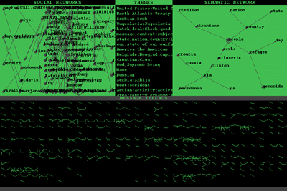‘Finding’ can be seen either as a paranoid or creative structure, carefully handled it tends to include both as a self-reflexive, thus attentive and critical attitude.
Accident finds happen to appear, when one focuses on an actual appeared thread and follows the line. This is closely related to my current thoughts on net and blogging structure, so it keeps me going that way. My regained interest on Mark Lombardi’s maps just points into a similar direction with further leading routes. In trying to define the architectural area of blogging within the territory of the net the following article of Francis Richard >(Cabinet Magazine) makes again interesting comparisons between the virtual outlay of maps and structuring elements and on the otherside the attitude of Lombardi’s art of mapping.
That I point back to the paranoid not only has to do with the almost non-visible structure of the cyberspace, but also with the habit of producing the real. This is an underlying main concept of all three terminologies I mentioned here: eventually evolving paranoid/fantastic constructions, the virtual space, and the map. Especially the last ones are definitely also relating to time and space. All three develop from very different narrative concepts and want to produce a more or less visible space.
…The map is a particular kind of story about reality….
…Nevertheless, the much-touted democratic connectivity of cyberspace is a prime example of Denis Wood’s rapidly expanding society-that is, a society in which mechanisms for stratification develop apace with the logarithmic expansion of enfranchisement. We are already entering a period where ubiquitous access, nonstop e-commerce, and increasing regulation encourage nostalgia for the rough-and-ready days of geek/hacker prospectors and cyber-cowboys. New frontiers do not resolve into habitual settlement without new maps, and the despoilation brought by crowds is only lamented after a site is on the map so that crowds can find it. Whether you view new maps as helpful tools, as Sack does, or weapons of control, like Wood, or even as organs of resistance a la Lombardi, depends on your perspective as a dweller in the opening environment.

>Warren Sack: VLS CONVERSATION MAP
– Utterance is place enough.
Ralph Waldo Emerson
As Lombardi’s phrase “narrative structures” tacitly admits, the mapped conversation is a constructed fantasy, a quixotic and intentional mix-up between quantitative and qualitative analysis. Maps belong (or seem to belong) in the domain of numbers and objective physicality, while conversation is a quintessentially subjective, immaterial process. It may be that projects juxtaposing the two invite failure, since they attempt to index the ineffable. But it might be said that we try to do that all the time. Mapping conversation is more unusual, but no more absurd, than composing written descriptions of smells or taking photographs of the Grand Canyon. In a sense, the scalar audacity with which Mark Lombardi and Warren Sack seek to bring their vast fields of study into tangible proximity with individual readers exemplifies the hubris and pathos of all signifying-art,-politics, and utterance included. If representation solidifies one and dematerializes the other, what is the difference between a moment and a place?
excerpts from F.Richards: Utterance is Place Enough: Mapping Conversation
